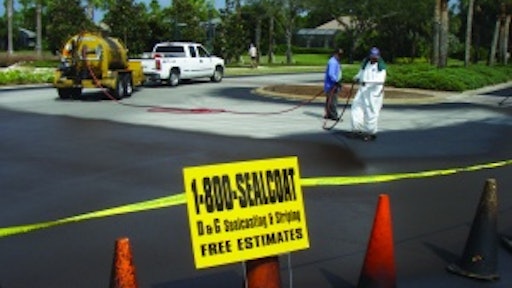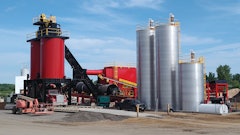
Small contractors often can be intimidated at the prospect of a large, high-profile, complex job, but at the same time most want to tackle one, too. Large jobs and high-profile jobs can help elevate a contractor to the next level, giving him or her the confidence to pursue even larger and more complex - and more lucrative - projects. Plus, succeeding in such a job can make getting similar jobs easier because you have a great reference to use in your marketing pieces, websites, and word-of-mouth advertising.
So when Dennis Deibel and Gail Shaw, co-owners of D&G Sealcoating & Striping, were approached to bid a complex, potentially influential, sealcoating and striping job at Pelican Landing in Bonita Springs, FL, they knew they had a great opportunity.
But Pelican Landing, which fit right into the major niche of homeowner associations D&G pursues, was a big step up for the small operation. And according to Deibel it required more than the attention to detail and communication with customers D&G is known for - it required the right equipment, some of which D&G had to pick up for the job.
D&G Sealcoating & Striping, Estero, FL, officially started in 2001 when Gail Shaw became sole owner of a business she had been assisting Deibel with since 1996. While Shaw worked outside the home as an accountant, Deibel tackled small sealcoating and striping jobs, hiring from a labor pool on an as-needed basis. "Back then a $2,000 to $4,000 job was a big job for us," he says.
A turning point came in 2005 when Deibel and Shaw were planning to buy a condominium for investment purposes with $25,000 down. "We did small jobs and did them very well but we were limited by the equipment we had," he says. "We knew we had to have the right equipment not only to do it right but to get bigger and better jobs."
So they reconsidered the purchase of the condo.
"We decided we needed the right equipment to go after bigger work more than we needed the condo, so we took that money and bought a Seal-Rite tank instead," he says.
Today, D&G employs fewer than five people, including Deibel and Shaw, and has established relationships with four golf courses and 12 property management companies. Commercial work accounts for 35% of sales and 65% of sales are in residential work primarily for homeowner associations, condo associations, and apartment complexes. D&G also pursues driveway work through its online and print Yellow Pages ads and through its 1-800-SEALCOAT number.
Deibel says 60% of their work is sealcoating, 20% is pavement marking, and the remaining 20% is a combination of pavement repair, concrete bumper installation, sign installation, and infrared work, which the contractor has offered for two years.
"Using the infrared heat process for asphalt repairs enabled us to get bigger sealcoating jobs because they'd see us doing seamless patches, liked what they saw, and gave us a shot at their other work," he says.
Pursuing an Influential Job
And it's their prior work that gave D&G an opportunity to bid Pelican Landing, a high-end residential community with more than 1,300 homes in the $1 to $2 million range. Properties are connected by 30 roads covering about 12 miles, and it's the roads, intersections, and cul-de-sacs Pelican Landing wanted sealcoated and striped.
Three years earlier, Pelican Landing opted for a rejuvenator, and the residents weren't happy with the finished product. Not only that, but Deibel says Pelican Landing told bidding contractors the contractor that applied the rejuvenator was difficult to deal with.
"Apparently he just didn't take the residents' concerns into account," Deibel says. "One example we were told was that the contractor's crew was stopping in front of people's homes and tramping across the lawns to run hoses for water from the homes to the tank. The people in the community were up in arms and it was a bad experience for them that they definitely didn't want to repeat."
In January 2008, D&G Sealcoating & Striping was one of six contractors asked to bid specific roads. They were invited to bid because people on the homeowner's association board and within the community knew about the quality of their work through other projects within the community.
"A year before we did a little roadway with a cul-de-sac in Pelican Landing, and one of the board members happened to be on the Master Board as well and he recommended we be asked to bid," Deibel says. "In addition, a couple of other people on the board frequented local restaurants which we had sealed a few years before. After sealing the parking lots, we had stenciled our company name and phone number into the corner of their parking lot. One of the individuals went to the parking lot to find our name and telephone number and he informed us that he had to crawl under a vehicle just to make sure that we were invited to bid."
Pelican Landing did more than six months of research, eventually asking six contractors to bid specific roads. For the initial phase Shaw went out and measured each road, including intersections and any additional work such as turn lanes or "onlys." Then D&G put together its initial bid.
By March 2008 Pelican Landing had narrowed the bidders to three and these finalists were then asked to include the remaining roads.
"One of the contractors was off by 100,000 sq. ft. because he didn't measure the roads going between the cul-de-sacs," Shaw says. "I don't remember why other people didn't make the cut, but Pelican Landing was pretty demanding mainly because they didn't want their last experience repeated.
"We knew we were in the running for the job because Pelican Landing was calling our references," Shaw says. She says Pelican Landing also liked D&G's sealer, PaveShield, an asphalt emulsion-based sealer manufactured by Neyra Industries.
"During the whole time we kept working and bidding on other jobs while pursuing Pelican Landing," Shaw says. "We scheduled other work during the time we would be working on the Pelican Landing project but we told them up front that we had to do that. We didn't want to put all our eggs in one basket. You can't put your business on hold hoping for one job - even a big job like that one -and they understood that."
D&G Sealcoating and Striping eventually was awarded the contract with the job to start in July, and Deibel and Shaw spent a lot of the intervening months planning the work. "We did spend a lot of time on that because the prior contractor just disrupted the community," Deibel says. Many hours were spent with Pelican Landing's Nancy Page and Cindy Reuter-Zingraff during the scheduling. Precise sealer calculations needed to be made on a daily basis while still making it convenient for people to either exit or enter the community.
"One of the first things we did was give them a large laminated color-coded map of the project, then we sat down with them to figure out when to do each part of the job," Deibel says. "Pelican Landing has one long road that goes north to south the length of the development with finger roads off that. We decided to work on every other finger road so people could park on the opposite road. We just worked with them to figure out how people could get in and out of their homes and the area as easily as possible. We didn't want to disrupt them."
Once the schedule was determined Pelican Landing contacted all residents with a letter, letting them know which roads were going to be done when. The homeowners' association also relied on e-mail and on its closed circuit television to keep residents informed about upcoming work, changes, and progress. The Pelican Landing security force directed traffic throughout the project.
"There was a lot of cooperation, but that was one of the things we brought to the bid," Deibel says. "We knew they wanted a contractor willing to work with them, and we showed them that not only could we do the work well under their schedule, we would work with them to minimize any disruption to the residents."
Equipment Provides Comfort Level
Deibel says that while D&G's experience, attention to detail, and willingness to work with residents played a role in landing the bid, the D&G equipment fleet gave Shaw and Deibel a comfort level to enable them to pursue the big high-profile job. He knew he had enough of the right mix of equipment to do a good job.
"If you're out on a job with a broken down blower or other equipment it makes you look bad and the job doesn't go smoothly," Deibel says. "It's an image thing."
But it's also a productivity thing.
Before the job started D&G Sealcoating & Striping had two 6,000-gal. bulk tanks (it is also a sealer supplier) a Seal-Rite 700 spray machine, and two Graco 3900 LineLazers with LineDriver attachments. Four 13-hp walk-behind blowers, a Shindaiwa power broom, and a KM International infrared unit with a 2-ton hot box reclaimer rounded out the fleet. But he says the piece of equipment that gave him the most productivity, allowing D&G to do quality work on schedule, was a Buffalo Turbine high-power blower, which enabled him to quickly clean the roads well, just prior to sealing.
"We do a lot of work on golf courses and we've seen them used. We also got a chance to use a 20-hp version borrowed from a golf course to move sand off the cart paths," Deibel says. "We eventually bought our own during the summer of 2008 after having talked with the company at a number of National Pavement Expo shows."
Deibel says the surface preparation process would start with scraping, cleaning, and priming of any oil spots. Then wire brooms and the power broom were used on especially dirty areas, followed by the walk-behind blowers. In some cases dirt and debris was blown into one area and then scooped up so it wouldn't blow on people's property. The pavement was cleaned again immediately before sealcoating using the Buffalo Turbine blower.
"The pavement can't be clean enough as far as I'm concerned for sealcoating, so that enabled us to get it as clean as possible," Deibel says, adding that the blower enabled D&G to get work done following overnight rain that left puddles and wet pavement. "The turbine blower really helps dry puddles on pavement," he says. "It enabled us to get on the job earlier because the horsepower and volume of air of the turbine that can blow more water."
Once D&G was awarded the job it decided it needed an additional sealcoating rig to get it all done on time. Deibel says they didn't want to buy a new rig but found the next best thing - a used rig that had hardly been used.
"We found a 700-gal. machine through an ad in Pavement Maintenance & Reconstruction. We called the guy in Arkansas, made him an offer, and he accepted," Deibel says. "But we needed the unit Monday morning to keep the job moving along, so on Saturday we left Florida and drove to Arkansas. We met him out on a country road and paid him right in the middle of the road, signed the papers by flashlight, drove it back, and filled it with sealer Monday. We were able to double our efficiency with two tanks."
Deibel says all sealcoating was done in two coats with a spray wand and all edging was done using a spray shield on the wand. The two rigs started at opposite ends of each road and drove toward the middle, sealcoating edges first. Once edges on both sides were sealcoated the rigs turned around and applied sealer to the center of the road all the way out.
Deibel says that once the sealer was dry the typical pattern was to apply a second coat in the center of the road. In some cases roads were edged again, but in most instances a wider spray pattern was used on the second coat to apply sealer not quite to the edge of the road.
"We did a good job on it, and now we use it as a reference," Deibel says. "It's been a big help for our business because now we can say we did all the roads in Pelican Landing, and that carries a lot of weight in our area. Everyone knows where it is, and they can just go out and look at it. And now we get calls on all sorts of other roads after that one."
Deibel says that in addition to helping D&G get other jobs, the Pelican Landing job opened many doors that had been closed.
"Since then we've hooked up with some management companies we'd never been able to get work from before," he says. "They saw how we were doing and now we're invited to bid on some of their projects. We're getting a lot of other jobs because of the Pelican Landing job."



























